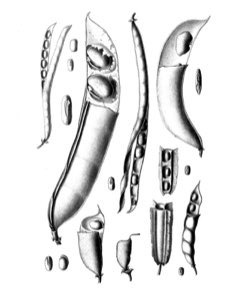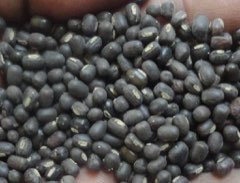 |
|
http://www.edibleplants.org |
 |
| Bhaskaranaidu wikimedia.org |
Translate this page:
Summary
Vigna mungo or also known in various common names such as Black Gram, Urd Bean, Black Matpe, and Black Mung Bean, is an erect, hairy, and bushy annual plant with a well-developed tap root and grows up to 100 cm in height. It is often grown in the Indian subcontinent. The pods are narrow and cylindrical with each pod containing about 4-10 small, black seeds. The leaves are composed of three oval leaflets each. Flowers are yellow and in dense clusters. Young seedpods and seeds are cooked and consumed as a vegetables. Dried seeds are boiled or ground into flour. The leaves are also edible. In traditional medicine, the seeds are used as a poultice on abscesses. Seed flour is rich in saponins and can be used as a substitute to soap. The plant has the ability to fix atmospheric nitrogen hence it is grown in some areas as green manure.
Physical Characteristics

 Vigna mungo is a ANNUAL growing to 1 m (3ft 3in) by 0.2 m (0ft 8in) at a fast rate.
Vigna mungo is a ANNUAL growing to 1 m (3ft 3in) by 0.2 m (0ft 8in) at a fast rate.
See above for USDA hardiness. It is hardy to UK zone 10. The flowers are pollinated by Insects. The plant is self-fertile.
It can fix Nitrogen.
Suitable for: light (sandy), medium (loamy) and heavy (clay) soils, prefers well-drained soil and can grow in heavy clay soil. Suitable pH: mildly acid, neutral and basic (mildly alkaline) soils and can grow in very acid and saline soils.
It cannot grow in the shade. It prefers moist or wet soil and can tolerate drought.
UK Hardiness Map
US Hardiness Map
Synonyms
Azukia mungo (L.) Masam. Phaseolus hernandezii Savi Phaseolus mungo L. Phaseolus radiatus Roxb. Phas
Plant Habitats
Edible Uses
Edible Parts: Leaves Seed Seedpod
Edible Uses:
Young seedpods - cooked and used as a vegetable[300 ]. The seedpods are about 40 - 70mm long and 5mm wide[300 ]. Seeds - cooked[300 ]. The dried seeds are boiled and used in a variety of recipes[301 ]. They can also be ground into a flour as a protein enhancing additive to flour when making bread etc[301 ]. In India they are an essential ingredient of idli and dosa - acid-leavened fermented cakes make from rice and dhal[301 ]. The ellipsoid, usually black seed is up to 5mm long[299 ]. Leaves[301 ].
References More on Edible Uses
Medicinal Uses
Plants For A Future can not take any responsibility for any adverse effects from the use of plants. Always seek advice from a professional before using a plant medicinally.
Astringent Poultice
In traditional medicine, the seed is used for its suppurative, cooling and astringent properties. For example, it is ground into a powder, moistened and applied as a poultice on abscesses[299 ].
References More on Medicinal Uses
The Bookshop: Edible Plant Books
Our Latest books on Perennial Plants For Food Forests and Permaculture Gardens in paperback or digital formats.

Edible Tropical Plants
Food Forest Plants for Hotter Conditions: 250+ Plants For Tropical Food Forests & Permaculture Gardens.
More

Edible Temperate Plants
Plants for Your Food Forest: 500 Plants for Temperate Food Forests & Permaculture Gardens.
More

More Books
PFAF have eight books available in paperback and digital formats. Browse the shop for more information.
Shop Now
Other Uses
Green manure Soap making
Agroforestry Uses: Plants are grown as a green manure[46 , 418 ]. In the wet season in India this species is mainly intercropped, with sugar cane, cotton, groundnut, sorghum or pigeon pea as the main crops. In the dry season it is often sole cropped on rice fallow[299 ]. Other Uses The seed flour is rich in saponins and can be used as a soap substitute[418 ]. It makes the skin smooth and soft[299 ].
Special Uses
Food Forest Nitrogen Fixer
References More on Other Uses
Cultivation details
A plant of the drier tropics, where it is found at elevations up to 2,000 metres. It grows best in areas where annual daytime temperatures are within the range 22 - 35°c, but can tolerate 8 - 40°c[418 ]. The plant does not tolerate frost. It prefers a mean annual rainfall in the range 650 - 900mm, but tolerates 530 - 2,430mm[418 ]. Rain at flowering time has a very adverse effect upon seed yields[410 ]. Plants are not adapted to wet, humid areas with high rainfall, but can, however, be grown in the dry season of wetter areas so long as this is at least 4 months in duration[300 ]. Requires a sunny position[418 ]. Grows well in well-drained, fairly heavy fertile soils[300 ]. Tolerant of moderate levels of salt in the soil[418 ]. Prefers a pH in the range 5.5 - 6.5, tolerating 4.5 - 7.5[418 ]. Established plants are drought resistant[300 ]. Immature pods can be harvested about 60 - 80 days after sowing[300 , 418 ]. Mature beans can be harvested after 75 - 130 days[418 ]. Yields of 500 - 650 kilos per hectare of dried seeds can be obtained[300 ]. The average yield of dry seeds in India can vary between 340 - 1,500 kilos per hectare[418 ]. There are some named varieties[300 ]. There are three main forms of this plant:- Var mungo. A large seeded, early maturing form with black seeds[299 , 300 ]. Var viridis Bose. A small seeded late maturing form with brown, green or grey seeds[299 , 300 ]. Ver silvestris Lukoki, Mar?chal & Otoul. The original, wild form. Most cultivars require short daylengths[300 ]. This species has a symbiotic relationship with certain soil bacteria, these bacteria form nodules on the roots and fix atmospheric nitrogen. Some of this nitrogen is utilized by the growing plant but some can also be used by other plants growing nearby[200 ]. When removing plant remains at the end of the growing season, it is best to only remove the aerial parts of the plant, leaving the roots in the ground to decay and release their nitrogen.
References Carbon Farming Information and Carbon Sequestration Information
Temperature Converter
Type a value in the Celsius field to convert the value to Fahrenheit:
Fahrenheit:
The PFAF Bookshop
Plants For A Future have a number of books available in paperback and digital form. Book titles include Edible Plants, Edible Perennials, Edible Trees,Edible Shrubs, Woodland Gardening, and Temperate Food Forest Plants. Our new book is Food Forest Plants For Hotter Conditions (Tropical and Sub-Tropical).
Shop Now
Plant Propagation
Seed - presoak for 12 hours in warm water and sow in situ. The seed generally sprouts within 7 - 10 days[299 ].
Other Names
If available other names are mentioned here
Adad, Arad, Karu-minimulu, Maga, Mas, Mash kalai, Masha, Matimah, Minumulu, Nallaminumulu, Tikari kalai, Uddu, Udid, Ulundu, Urad, Urd dhal, Urdi, Uzhunnu, ambérique, black gram, fagiolo urd, feijão-da-china, frijol mungo, haricot mungo, mash, mash kalai, masha, moong, mung bean, urd, urd bean, urd-bean, urdbohne, urdböna, urd|ulundu / urd.
Native Range
TROPICAL ASIA: Bangladesh, India, Pakistan, Myanmar (west)
Weed Potential
Right plant wrong place. We are currently updating this section.
Please note that a plant may be invasive in one area but may not in your area so it's worth checking.
Conservation Status
IUCN Red List of Threatened Plants Status : This taxon has not yet been assessed

Growth: S = slow M = medium F = fast. Soil: L = light (sandy) M = medium H = heavy (clay). pH: A = acid N = neutral B = basic (alkaline). Shade: F = full shade S = semi-shade N = no shade. Moisture: D = dry M = Moist We = wet Wa = water.
Now available:
Food Forest Plants for Mediterranean Conditions
350+ Perennial Plants For Mediterranean and Drier Food Forests and Permaculture Gardens.
[Paperback and eBook]
This is the third in Plants For A Future's series of plant guides for food forests tailored to
specific climate zones. Following volumes on temperate and tropical ecosystems, this book focuses
on species suited to Mediterranean conditions—regions with hot, dry summers and cool, wet winters,
often facing the added challenge of climate change.
Read More
Expert comment
Author
(L.) Hepper.
Botanical References
Links / References
For a list of references used on this page please go here
A special thanks to Ken Fern for some of the information used on this page.
Readers comment
| Add a comment |
|
If you have important information about this plant that may help other users please add a comment or link below. Only comments or links that are felt to be directly relevant to a plant will be included. If you think a comment/link or information contained on this page is inaccurate or misleading we would welcome your feedback at [email protected]. If you have questions about a plant please use the Forum on this website as we do not have the resources to answer questions ourselves.
* Please note: the comments by website users are not necessarily those held by PFAF and may give misleading or inaccurate information.
To leave a comment please Register or login here All comments need to be approved so will not appear immediately.
|
|